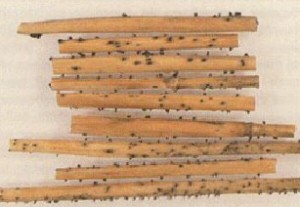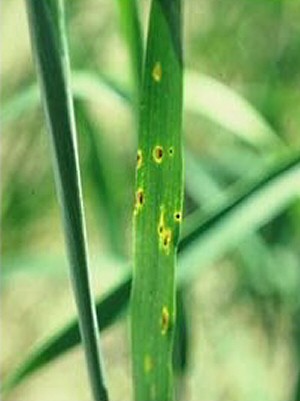Tan Spot On Wheat
 Causal Agent
Causal Agent
The fungus Pyrenophora tritici-repentis.
Hosts
Wheat
Symptoms
Tan spot lesions on leaves characteristically have a small, tan to brown center, which is surrounded by a yellow circular border. As leaves mature, lesions expand, kill tissue, and can impart a tannish hue to leaves. Lesions, which initially are found in late winter or early spring on lower leaves, result from infection by spores released from fruiting bodies that formed on wheat residue left in the field after harvest.
Control
 Cultural practices, variety selection, and fungicides can be used to control tan spot.
Clean tillage and crop rotation facilitate destruction of residue, which reduces inoculum
present to start the disease. Fungicides (consult with your county extension agent
or the current edition of the OSU Extension Agents’ Handbook of Insect, Plant Disease,
and Weed Control) can be applied to prevent infection and spread of tan spot, but
rarely would this be economically beneficial in Oklahoma. Some varieties are more
resistant to tan spot than others. If tan spot is a concern, consult with your seed
dealer, extension agent or information such as the, "Wheat Variety Comparisons Chart,
1997," Production Technology - Crops, July, 1997, vol. 9, no. 17 (revised) to identify
varieties resistant to tan spot.
Cultural practices, variety selection, and fungicides can be used to control tan spot.
Clean tillage and crop rotation facilitate destruction of residue, which reduces inoculum
present to start the disease. Fungicides (consult with your county extension agent
or the current edition of the OSU Extension Agents’ Handbook of Insect, Plant Disease,
and Weed Control) can be applied to prevent infection and spread of tan spot, but
rarely would this be economically beneficial in Oklahoma. Some varieties are more
resistant to tan spot than others. If tan spot is a concern, consult with your seed
dealer, extension agent or information such as the, "Wheat Variety Comparisons Chart,
1997," Production Technology - Crops, July, 1997, vol. 9, no. 17 (revised) to identify
varieties resistant to tan spot.

